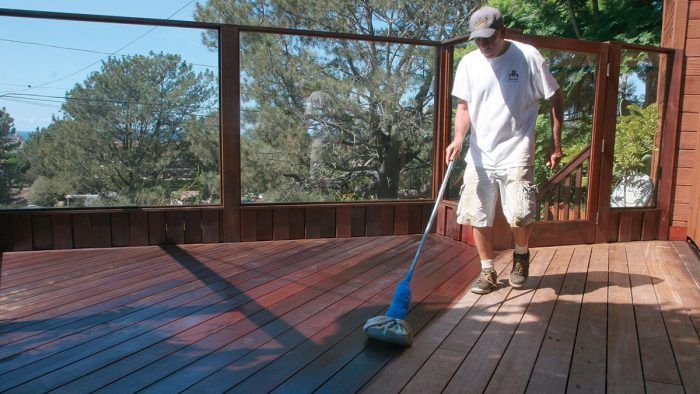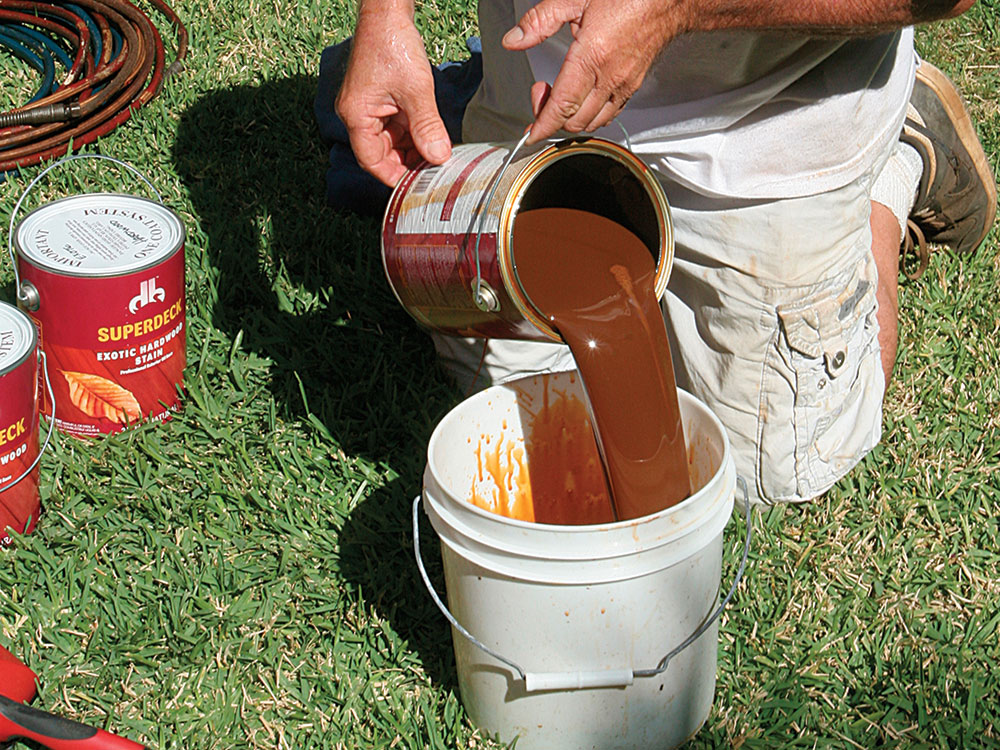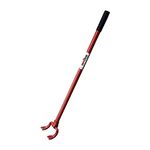Annual Deck Maintenance
A yearly checkup in spring or fall will keep your deck looking its best.

An annual checkup is the minimum maintenance required for a deck. Either spring or fall will work. A spring checkup has the advantage that you can immediately repair any damage from the winter, apply a fresh coat of UV protection, and have your deck looking its best during the main season of use. On the other hand, a fall checkup has the advantage that you are applying sealant protection at the time it will provide the most benefit from the harsh winter conditions. To keep a deck looking its best, plan to do something in both the spring and fall.
Cleaning is the first step
In moist climates like the southeast and Pacific Northwest, mold, mildew, and moss can grow quickly on decking. In cold climates, a deck can have dirt and grit from harsh winters as well as residue from de-icing agents. Getting rid of the mold and dirt that has accumulated on the deck can be done with a bristled brush or a pressure washer. If the deck is cedar or pressure treated, then it’s best to use deck cleaner and a scrub brush because the wood is softer and is easily damaged by a pressure washer. Some deck cleaners are harmful to plants, so read the label carefully and take necessary precautions.
If the deck is composite or a tropical hardwood, consider using a pressure washer. However, be careful with this machine. While a pressure washer can clean a deck, it can also do a lot of damage. Before cleaning the main part of the deck, do a test on decking that is hidden to check if your decking can withstand the pressure of the water. The water will literally gouge soft woods like cedar if the washer tip is brought too close to the surface. The same is true for the siding of your house or the skin on your foot, so wear protective clothing on your feet, hands, and face.
Once you have determined the proper distance to maintain between the tip of the washer and the deck, the fun can begin. Pressure washing is an immensely rewarding activity because the results are instantaneous.
Deck Maintenance Checklist
Completing this simple checklist of maintenance items will remove much of the guesswork of what to do.
- Clear it. Keep the deck clear of debris. Don’t use a deck as a storage area for lumber, yard supplies, tools, or other items that should be stored in a garden shed.
- Clean it. Have a regular cleaning schedule and stick to it. Most decks require cleaning only twice a year.
- Protect it. Regularly apply a sealer, stain, or paint. As with cleaning, establish a regular schedule and stick to it.
- Inspect it. While doing your regular maintenance, take the time to inspect the deck for rot, insects, and other damage.
- Repair it. You don’t have to fix every issue as soon as you find it but be sure to make time to address problem areas during the time of regular maintenance. One small issue can become a major problem if left unattended.
- Invest in it. Continue to improve you deck and modify it to suit your changing needs. The more you use your deck, the more apt you are to take good care of it.
Repair what the weather has wrecked
When approaching repair, start with the most obvious problems. Look for deck boards that are starting to rot or are badly checked. For these boards, it is often easier to replace the entire board rather than just cut out the bad part. Think of replacing a board as doing surgery. You will need to take out the bad part while protecting everything else. If you have an extra sheet of plywood, lay that down to work off of and stage your tools. Reciprocating saws and multitools can be extremely useful for cutting fasteners that are fused to the wood (like galvanized nails) or weak from corrosion (like screw shanks).

Replacing other elements of the deck is an even greater challenge because, like the deck boards, you have to fight fasteners and make precision cuts without damaging the surrounding deck. In addition, surrounding pieces of the deck need temporary support so that they don’t sag, fall, or rack during the repair. As always, take the time to think through all phases of your project so there aren’t any ugly surprises when the saw makes its way all through the piece of wood.
Finally, give the deck a once over and tighten any fasteners that worked loose during the seasons. The expansion and contraction of wood and other materials can work fasteners loose. To really be effective, look for loose fasteners at the driest time of the year when the wood has shrunk to its smallest dimensions.
Protect your work with a finish coat
The first year or two, no matter what type of finish you’ve chosen, you will want to apply a coat in the spring and fall. After that, the frequency of touching up the finish coat will depend on the look you want.

If you’ve let the deck go gray and are just using a sealant for protection, then one coat a year should be sufficient. If you’ve decided to try to maintain a new natural-wood appearance, then be prepared to get your brush out two or even three times a year.
The more pigment a finish has, the more it will act like paint. Like paint, this type of finish tends to peel if you aren’t careful when applying it. The surface needs to be clean, dry, and undamaged by the sun.
1. To prevent lap marks, spray on the finish one board at a time.
2. Use a painter’s pad on a long pole to smooth out the layer of finish applied with the sprayer.
3. Allow the finish to be absorbed fully (about 10 minutes) and then remove the excess with a rag or a rag-covered scrub brush.
4. The refinished deck.
Use a brush for stairs and other tight spots that are too awkward to spray. A handheld painting pad also works well for applying finish to areas too small to spray.
Fine Homebuilding Recommended Products
Fine Homebuilding receives a commission for items purchased through links on this site, including Amazon Associates and other affiliate advertising programs.

Standard Marking Chalk

Angel Guard Deck Demon

N95 Respirator










